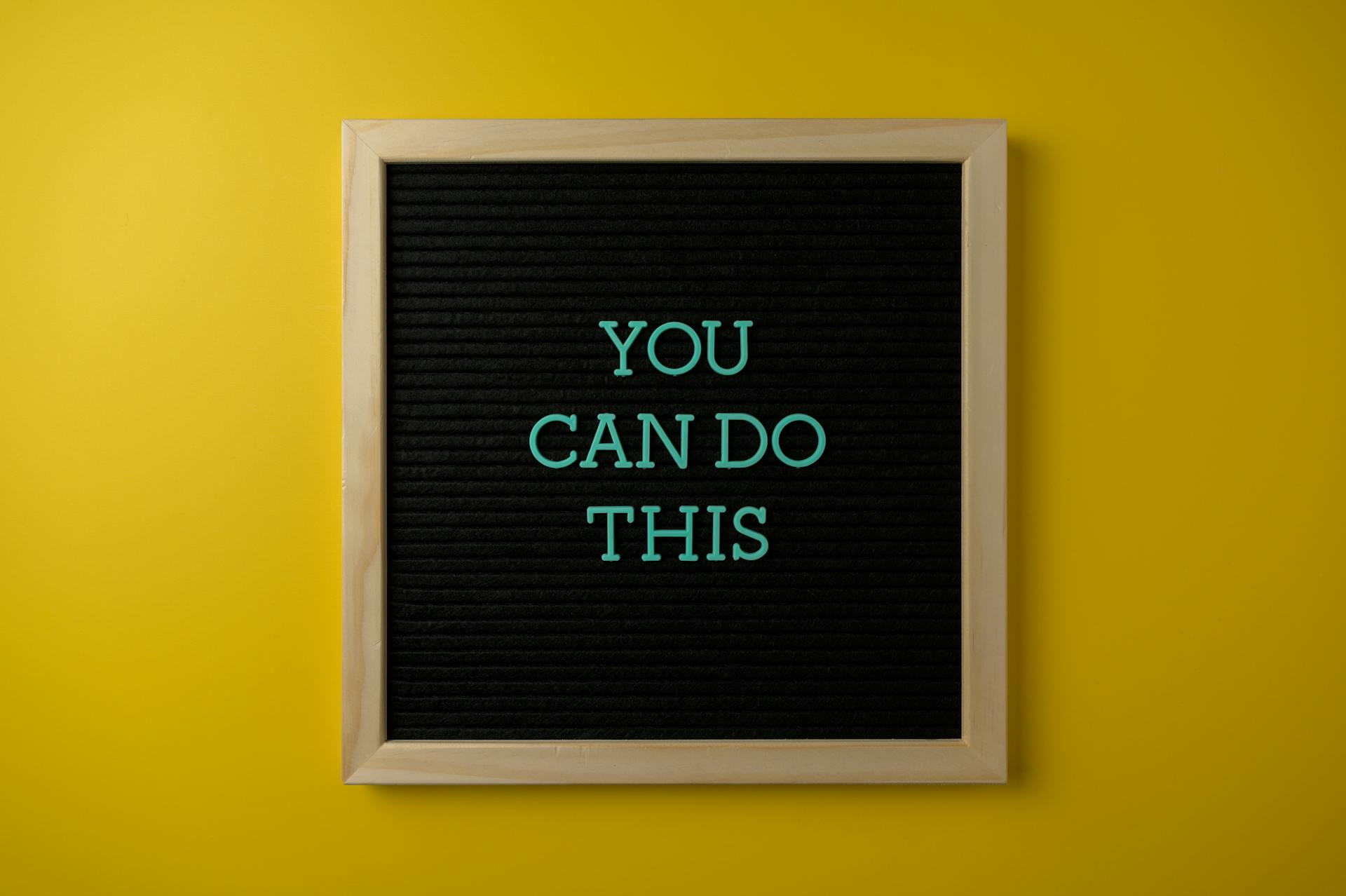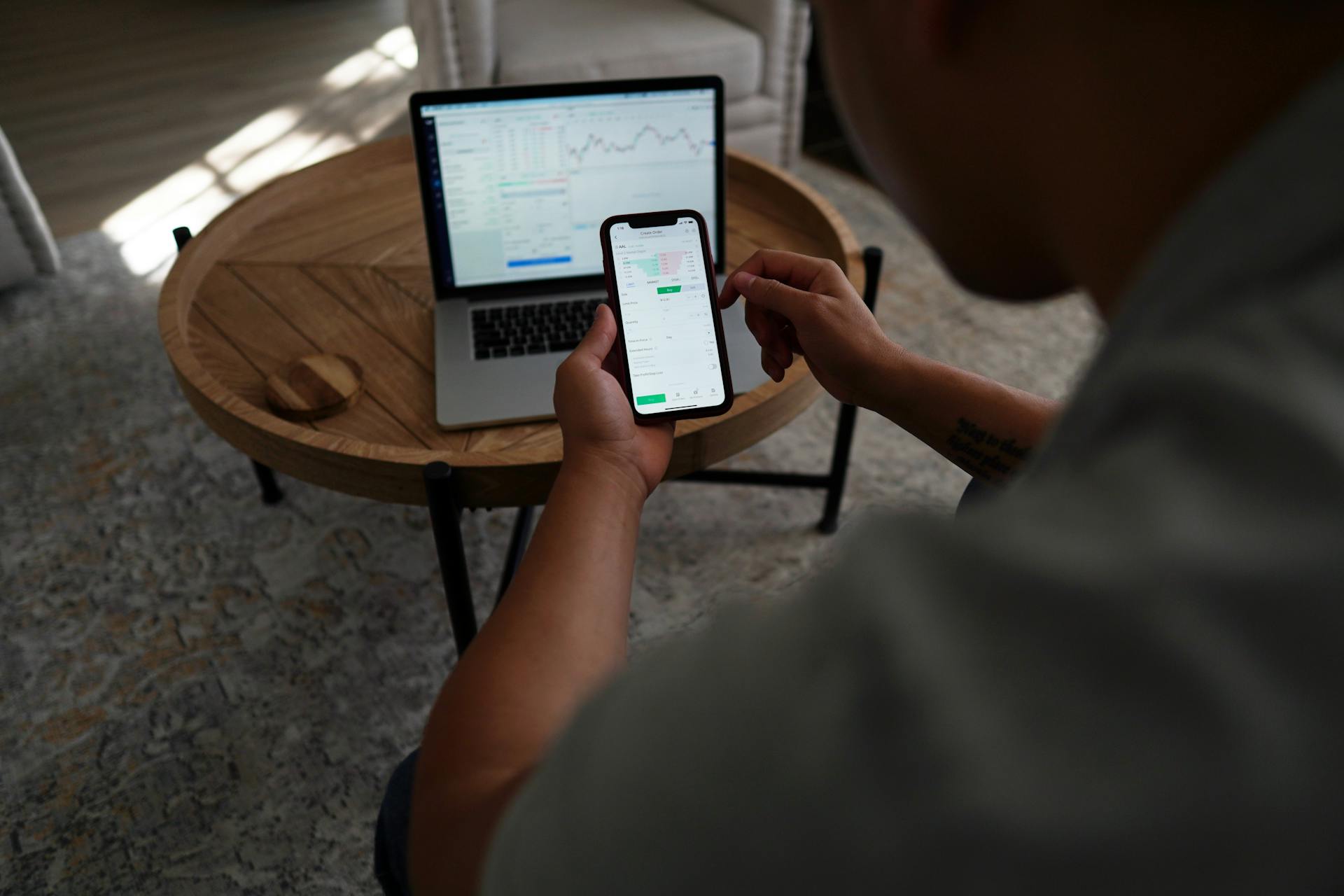
Becoming a successful day trader requires a solid understanding of the markets and a well-thought-out strategy.
To start, it's essential to have a strong foundation in technical analysis, which involves studying charts and patterns to make informed trading decisions.
A good day trader should be able to analyze a stock's price movement and identify trends, which can be done using various technical indicators such as moving averages and RSI.
It's also crucial to have a solid understanding of risk management, as day trading involves taking on a high level of risk.
To mitigate this risk, it's essential to set a budget and stick to it, as well as to use proper position sizing and stop-loss orders.
Day traders should also be able to adapt quickly to changing market conditions, which can be achieved by staying informed and up-to-date on market news and trends.
What Is Day Trading
Day trading is the practice of buying and selling assets within the same day, aiming to profit from small price movements in highly liquid markets.
You'll need to be able to make decisions quickly and manage risks while executing deals rapidly.
Day traders rely on market news and technical analysis to identify trading opportunities.
Long-term investors hold assets for months or years, whereas day traders exit their positions by the end of the day to avoid overnight market risks.
Even small price changes can lead to significant profits or losses when dealing with a large volume of an asset.
Getting Started
Start small in your trades to stay in the game longer and learn more about the markets. This approach prevents you from blowing up your account before finding consistency.
Going too big too soon can result in losses too big to recover from. It's always better to play it safe and trade with a small position size at first.
Once you've chosen a broker, you'll need to open an account and fund it. This process involves filling out an application, verifying your identity, and depositing money.
Employment Status
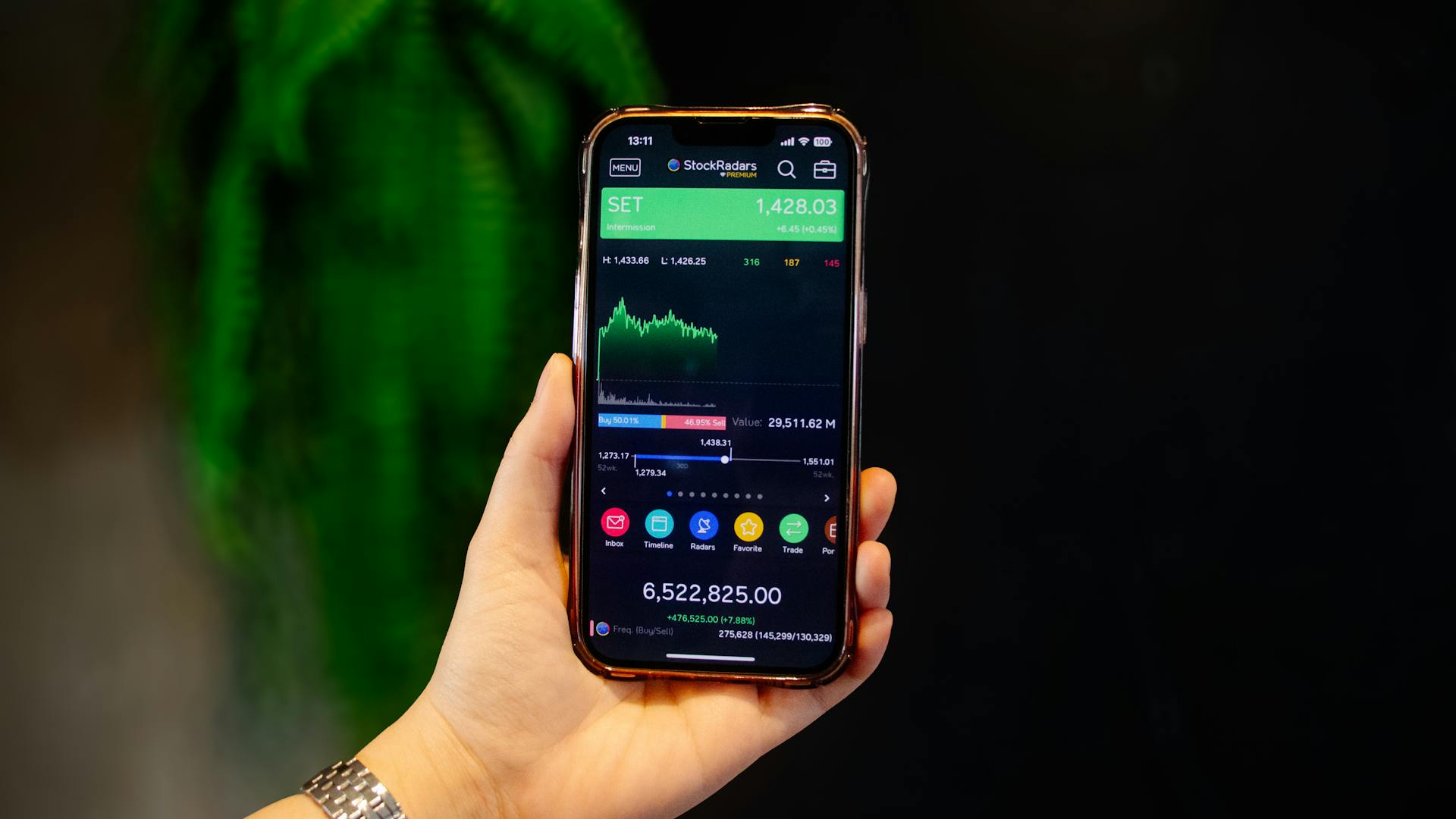
As a beginner, it's essential to understand your employment status as a day trader. You can be a casual day trader, a part-time day trader, or a full-time day trader.
Casual day traders tend to buy stocks randomly, and may take weeks or months between trades. This approach is not recommended without proper experience and consistency.
Part-time day traders trade once or a few times per week, often limiting themselves to specific market sessions like mornings or afternoons. This schedule allows for some trading experience while still allowing time for other pursuits.
Full-time traders, on the other hand, dedicate themselves to watching and trading the markets full-time, requiring significant knowledge and experience. This level of commitment demands a strong trading education and a steady income to support yourself while growing your trading account.
Start Small
Start with a small investment you can afford to lose. It's tempting to jump into day trading with large amounts of capital, but that can often be a mistake for beginners.
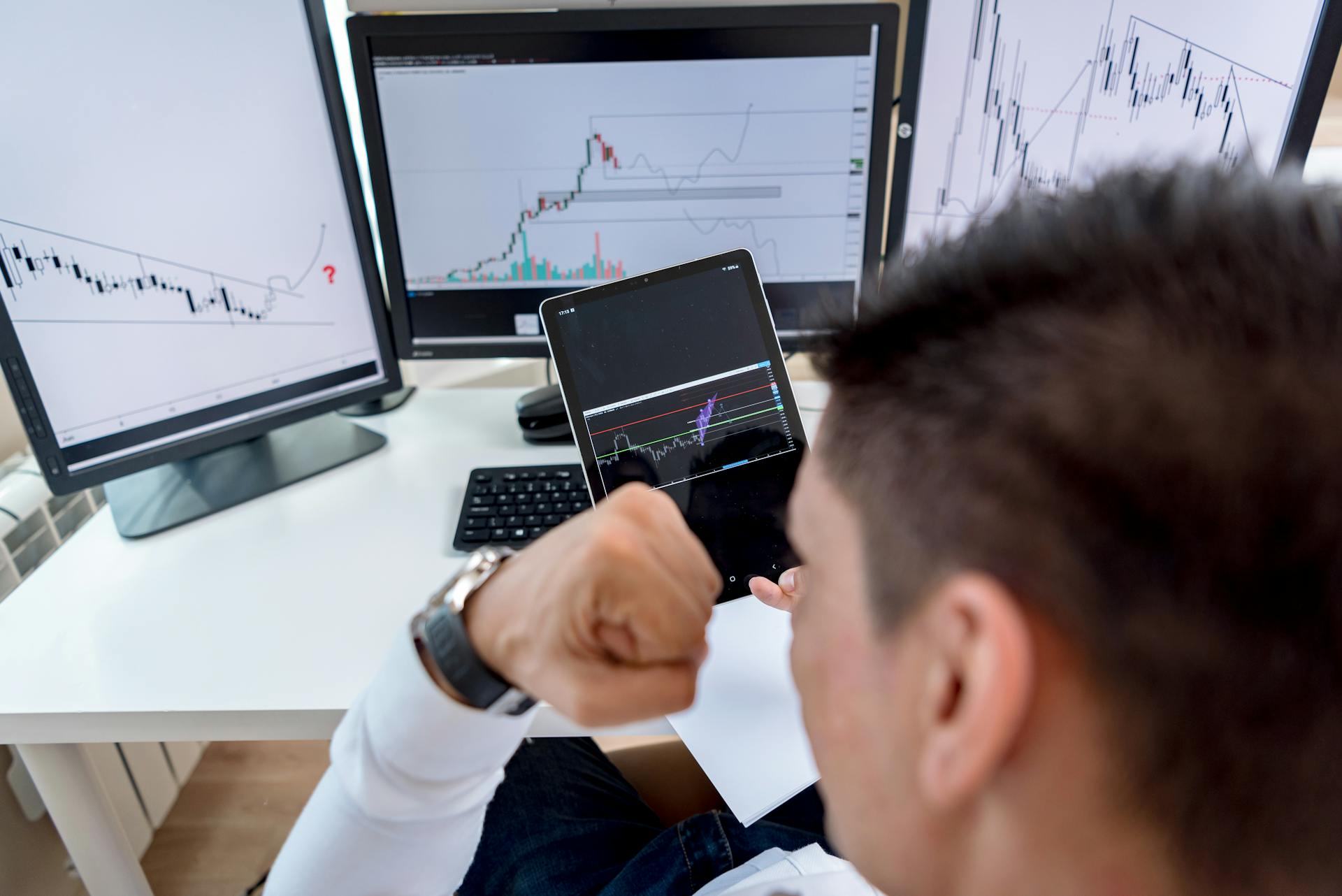
Going too big too soon can result in losses too big to recover from, so it's essential to play it safe and trade with a small position size at first.
You can start with a small account, such as $12,000, to force yourself to think like a beginning trader and be more careful with your trades.
Fine-tune your strategy and discipline with a small account, and then gradually increase your deal sizes as you gain experience and earn profits.
It can take months or even years to develop the skills and confidence needed to become consistently profitable, so be patient with yourself and continually review your performance.
Carefully track your wins and losses to get better and make informed decisions about your trades.
Trade with a small position size at first, and once you're consistent with a strategy, you can size up slowly.
On a similar theme: How to Trade Xauusd
Choose a Broker
Choosing a broker is a crucial step in getting started with day trading. Be wary of offshore brokers, as they are not FDIC insured, which means you won't be protected in case something goes wrong.
Different brokers are good for different strategies, so choose one that aligns with your trading style. Some popular brokers for day trading include E*TRADE, TD Ameritrade, and Interactive Brokers.
When selecting a broker, consider their fees, as day trading often attracts more fees due to the high volume of transactions. Choose a broker with low fees to save you money in the long run.
A user-friendly platform and excellent customer service are also essential when choosing a broker. Your broker is your gateway to the market, so make sure you're comfortable with their tools and support.
I began with Robinhood for its simplicity, but later transitioned to Interactive Brokers for more advanced tools. This shows that even experienced traders can change their broker to suit their needs.
Recommended read: Brokers with No Pattern Day Trader Rule
Day Trading Strategies
To become a successful day trader, you need a solid trading strategy. A good strategy will help you make informed decisions and avoid buying and selling random stocks.
You should find a strategy that works for you and has a good risk/reward ratio. This will help you manage your risks and maximize your profits.
Mastering technical analysis is also crucial for day traders. You'll need to study charts and use indicators like moving averages and the relative strength index (RSI) to predict price movements.
Examples of Successful Day Traders
Becoming a successful day trader requires dedication and hard work. Tim Grittani, a renowned penny stock trader, didn't make money for his first nine months.
Some of my top students have made over $12 million, including Tim Grittani. They've also achieved six-figure success, such as Jack Kellogg and Mike “Huddie” Hudson.
These successful traders give back to the community by helping newbies in chat rooms and with webinars. They stay humble, which inspires me and makes me proud.
Recommended read: How to Be a Successful Day Trader
Strategy
Developing a trading strategy is crucial for day trading success. It's essential to have a clear plan in place to guide your trades and help you achieve your financial goals.
You have to find a strategy that works for you and has a good risk/reward ratio. This means testing different approaches and sticking to what works.
A good trading strategy should include risk management, entry and exit points, and stop-loss orders. This helps you limit your losses and maximize your profits.
Risk management involves setting a limit on how much you're willing to lose on any trade. Many investors follow the 1% rule, where you never risk more than 1% of your money on just one investment.
You should set the price you'll buy and sell at before purchasing any asset and stick to these thresholds. Entry and exit points can help prevent you from buying a stock at a price that's too high and discourage you from holding onto shares in hopes of making a little more money.
Here are some key components of a successful trading strategy:
- Risk management
- Entry and exit points
- Stop-loss orders
These tools and techniques can help you navigate the markets and make informed trading decisions.
It's also essential to master technical analysis to make decisions and predict price movements. This involves studying charts and using indicators like moving averages and the relative strength index (RSI) to spot trends and set your entry points.
You can also use platforms like Gorilla Trades to get actionable intelligence and mitigate risks.
Remember, developing a trading strategy takes time and practice. Start with a simple strategy and refine it as you gain experience.
Tools and Software
Day trading software is a must-have for any day trader. There are a lot of choices when it comes to trading software.
You'll also need a reliable setup to trade comfortably. A fast computer is essential, and a high-speed internet connection is a must.
Multiple monitors can be a big help in keeping track of different data streams, making it easier to stay on top of your trades.
Software
Day traders use software or trading platforms to chart and trade. There are a lot of choices when it comes to trading software.
A fast computer is essential for day trading, allowing you to process large amounts of data quickly. Day trading requires a reliable setup.
Multiple monitors can also help keep track of different data streams, giving you a clear view of the market.
Tools and Software
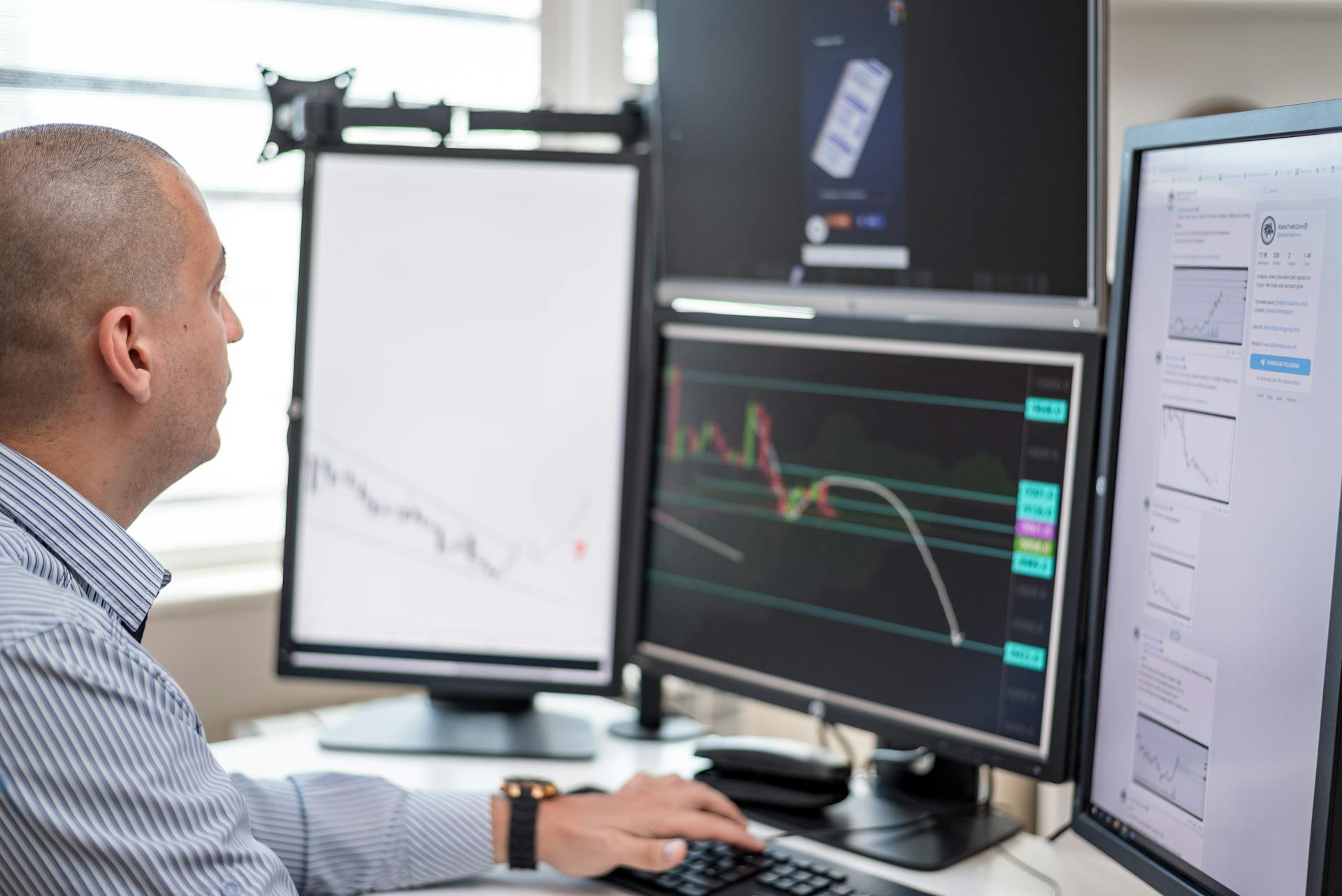
Be wary of offshore brokers, as they're not FDIC insured, leaving you uninsured if something goes wrong.
Choose a reliable broker that offers a user-friendly platform, low fees, and excellent customer service, like E*TRADE, TD Ameritrade, or Interactive Brokers.
Some popular brokers for day trading include E*TRADE, TD Ameritrade, and Interactive Brokers, which offer a range of tools and services.
Personal Tip: Consider starting with a simple platform like Robinhood, but be prepared to transition to a more advanced broker like Interactive Brokers as you gain experience.
Don't be fooled by apps and platforms with limited services and charts, as they may not provide what you need to succeed as a day trader.
Look for a company with good order execution time and one that meets all your needs, even if it means having accounts with multiple brokers.
There are over five million hits for 'how to become a day trader with $100', but remember, making money trading stocks takes time, dedication, and hard work.
Explore further: Td Ameritrade Pattern Day Trader
Brokerage Fees
Choosing a broker is crucial, as high-volume trading often incurs more fees.
Brokerage fees can be a significant expense, especially for high-volume trading. This is because a single day can involve a high number of transactions, leading to higher fees.
Carefully select a broker to minimize fees, as some brokers may charge more than others.
For more insights, see: Street Smarts High Probability Short Term Trading Strategies
Tips for Success
To become a successful day trader, it's essential to put in the hard work and dedication required to master the craft. This means practicing and honing a specific method for at least 6 months or more, five days a week, without distraction or trying out different things.
A well-structured trading plan is also crucial, outlining how you'll handle everything related to your trading and yourself. This includes strategies for managing risk, mastering patterns, and setting rules to stay on track.
Here are some key elements to consider when building your trading plan:
- How you'll handle losing streaks and big wins
- Position-sizing and taxes
- Steps to improve and review your results
- Goals, routines, and balancing life and trading
- How you'll handle fear and greed in a trade
With a solid trading plan in place, you'll be better equipped to develop confidence in your method and execute it day in and day out when real money is on the line. Remember, confidence is misplaced without a trading plan, loads of practice, and improving problem areas.
Benefits of Day Trading
Day trading can be a lucrative way to make money, allowing you to generate profits in a short period of time.
With the right strategy, you can make up to 100% of your investment in just one day.
This is because day trading involves buying and selling securities within a single trading day, allowing you to capitalize on small price movements.
You can make money by selling a stock for a higher price than you bought it for, or by buying a stock that's about to rise in value.
In fact, some day traders are able to make 10 trades in a single day, generating significant profits.
However, it's essential to have a solid understanding of technical analysis and market trends to succeed in day trading.
This includes being able to read charts, identify patterns, and make informed decisions based on market data.
By doing so, you can increase your chances of making a profit and minimizing your losses.
You might like: Trader in Stock Market
The Bottom Line
Success in day trading requires a lot of studying. Start with a thorough overview of key trading lessons, such as "The Complete Penny Stock Course" by Jamil.
To execute trades effectively, be disciplined and stick to your strategy, avoiding impulsive decisions and letting your plan guide your trades.
Cutting losses quickly is crucial, as it can help prevent significant financial losses. In fact, a study found that households that traded most averaged an 11.4% annual return, while the overall market gained 17.9%.
Most active traders lose money, with fees and overtrading being major contributors to these losses. A 2000 study evaluated 66,465 U.S. households that held stocks from 1991 to 1996 and found that the households that traded most had lower returns.
To become a successful day trader, you must start with your education, learn to manage your risk, master the patterns, and set yourself up with some rules. This will help you navigate the market and make informed decisions.
The available research on day trading suggests that most active traders lose money, with a 97% chance of losing for traders with more than 300 days actively trading. A 2014 paper analyzed the complete transaction history of the Taiwan Stock Exchange and found that 97% of day traders can expect to lose money from trading.
It's essential to focus on implementing your strategies and improving your problem areas, rather than listening to others' success or failure stories. What happens to you is based on what YOU do.
Trading is hard work, but it is possible for those who are dedicated to succeeding at it. With the right mindset and approach, you can increase your chances of success in day trading.
You might like: How Do Day Traders Make Money
Successful
Success in day trading is not just about luck, but about hard work and dedication. It takes a lot of studying to become a successful day trader, and even then, it's no guarantee of success.
Tim Grittani, a renowned penny stock trader, didn't make a profit for his first nine months, but he's now made over $12 million. This shows that even the most successful traders have gone through a period of struggle and learning.
To become a successful day trader, you need to put in a lot of efficient work, which means having defined steps and protocols for improvement and measuring that improvement. It's not just about putting in hours, but about being focused and consistent in your efforts.
You can't buy a competitive advantage, it has to be earned through hard work and dedication. This includes practicing and honing a specific method for at least 6 months or more, five days a week, without distractions.
Here are some key areas to focus on:
- Practicing and honing a specific method for at least 6 months or more, five days a week
- Finding problem areas and working through them in terms of strategy or psychology
- Building a Trading Plan that outlines your goals, routines, and strategies for managing risk and staying disciplined
- Developing confidence in your method and yourself, earned through consistent practice and improvement
It's also important to note that the available research on day trading suggests that most active traders lose money. In fact, a study found that 97% of day traders can expect to lose money from trading.
Consider reading: Percentage of Successful Day Traders
Frequently Asked Questions
How much can you make day trading with $1000?
With a $1,000 trading account and a 2% risk per trade, you can expect to earn around $20 per trade, but to make a profit, you'll need to win more trades than you lose
How much does an average day trader make?
According to Zipia, the average day trader makes around $116,000 per year, but this figure can reach up to $178,000 for those working at prop firms.
What is the 3-5-7 rule in trading?
The 3-5-7 rule in trading is a risk management strategy that limits individual trade risk to 3% of capital, maintains overall exposure at 5%, and aims for 7% profit gain on winning trades. This rule helps traders balance risk and reward for more sustainable trading.
How do I start day trading as a beginner?
To start day trading as a beginner, follow these 5 essential steps: research trading strategies, develop a trading plan, choose a platform, fund your account, and begin with small positions, all while maintaining discipline. Start your day trading journey today and learn more about each step to achieve success.
Is $100 enough for day trading?
While $100 is technically enough to start day trading, a successful strategy is crucial to making it work, regardless of the initial capital.
Sources
- https://www.timothysykes.com/blog/how-to-become-a-day-trader/
- https://www.gorillatrades.com/how-to-become-a-day-trader-a-step-by-step-guide/
- https://www.kotaksecurities.com/investing-guide/intraday-trading/10-steps-to-become-a-day-trader/
- https://www.elidge.com/how-to-become-a-day-trader-a-beginners-guide/
- https://tradethatswing.com/the-day-trading-success-rate-the-real-answer-and-statistics/
Featured Images: pexels.com

